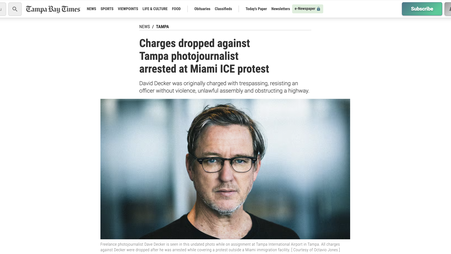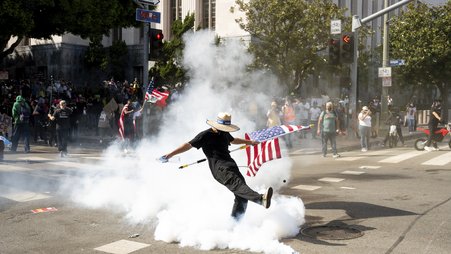
Riot police and protestors at Trump inauguration in Washington DC
I was arrested in Washington, D.C. on January 20 along with more than 220 people, while covering protests outside Donald Trump’s inauguration. I’m a journalist, and I’ve covered protests for years. I’ve been pepper-sprayed and tear-gassed in the course of those events; it’s somewhat unavoidable. But I’ve never been arrested, and though my day in jail wasn’t the stuff of prison horror stories, it was a stark reminder of the glaring imperfections of the American justice system, and a potential indicator of things to come in a press-averse administration.
The morning was frenzied; black-clad activists, many donning the masks and “black bloc” tactics long associated with anarchists, staged an unsanctioned march at McPherson Square. By 10 a.m., some march participants had attacked windows of apartment buildings, banks, and gas stations. Protesters smashed the windows of a parked limousine (later in the day, someone would set fire to it), and the facade of a Starbucks at 13th and I street was completely demolished as terrified customers huddled beneath tables.
By design, the “black bloc” makes it difficult to assign blame to a specific individual. A masked, black-clad protester would often emerge from the crowd of marchers, strike a window, and hurry back into the marching mass. How many of the protesters engaged in vandalism, and how many limited their action to marching? At any one moment, I witnessed about a dozen protesters destroy their surroundings, be it a streetside newspaper bin or a coffee shop window. Was it the same dozen who smashed the limo? It’s impossible for me to say.
After the Starbucks destruction, police responded in force, spraying liberal amounts of pepper spray and deploying flash bang grenades in attempts to disperse the crowd. One group managed to surge through a police barricade at the intersection of 12th and L streets, but officers quickly regrouped, penning in the roughly 200 people who hadn’t attempted to push past them. The group – which included protesters, journalists (including myself), medics, and legal observers – raised their hands in the air and awaited further instructions from the police.
I livestreamed the detention on Facebook. After about 40 minutes, police officers from DC’s Metropolitan Police Department began pulled me from the group (livestreamers were among the first arrested). As I’ve done in numerous protests since 2008, I showed officers my camera and business cards and explained that I was a journalist.
“That’s great,” one officer replied. “I’m a sergeant.”
Mass arrests – or “kettling” – have been uncommon in the nation’s capital ever since 2002, when then-Assistant Police Chief Peter Newsham ordered the arrest of roughly 400 people during an anti-World Bank/IMF demonstration in Pershing Park. The arrestees reportedly included nurses and attorneys walking to work, and the ensuing outrage resulted in years of litigation and an $8.25 million settlement on the part of the Justice Department and Department of the Interior. Newsham, now the interim chief of police in DC, was asked about the possibility of mass arrests a few days before the 2017 inauguration.
“You always have to prepare for mass arrests,” he said, “But we’re hopeful that it does not occur.”
I wasn’t the only journalist caught in the mass arrest. Alexander Rubinstein of RT America and four other freelance journalists – Matthew Hopard, John Keller, Shay Horse, and Aaron Cantú – went to jail with me. Strangely, some journalists were released: Reporters from NBC were allowed to leave the group of detainees, as was the independent journalist Tim Pool.
The bulk of my day was spent in a holding cell at the District 1 police station. The nine other men in my cell – aged 19 to 65 – were largely good-humored about their predicament. At a desk close to our cell, an officer took calls from friends and family, informing us if someone called on our behalf.
"Is your girlfriend gonna call, Richie?" asked Gabriel Mielke, 20.
"Nah," said Richie Allen, 19. "She hates this stuff.” Then, playing at the role of a disaffected boyfriend, he smirked, "My girlfriend's praxis is so bad."
The air in the cell still stung with the scent of pepper spray, which had permeated the sweatshirts and jackets of several prisoners. At one point, a police officer emerged from a row of cells in the back, shaking her head. "It smells like OC back there!" she exclaimed, referencing the technical name for pepper spray.
In jail, I considered my situation. The United States is, largely, a good place to be a journalist, with roughly 50,000 people practicing the job mostly free of government repression. But vitriolic statements from the Trump administration – and previously, the Trump campaign – have put press freedom advocates on edge; Trump’s chief strategist Steve Bannon called the media “the opposition party” in a January 25 interview with The New York Times. The president echoed his aide’s statement days later, saying of the press, “The dishonesty, the total deceit and deception makes them certainly partially the opposition party, absolutely."
But palty relations between American government and media didn’t start with Trump. For years, Reporters Without Borders, which tracks press freedom throughout 180 countries, has noted declining press freedom in the U.S. Today it ranks the nation at just 41, poorer than Ghana, Chile, and South Africa. That’s down from three years ago, when the U.S. held the still-barely-getting-by rank of 32. Obama-era prosecutions of whistleblowers played a large part in the precipitous decline, as did detentions of journalists at protests like the one I covered in January. In 2014, several reporters faced police actions while covering protests in Ferguson, Missouri, one of whom (Ryan Devereaux of The Intercept) was tear-gassed and shot with a rubber bullet prior to his arrest.
After roughly nine hours at the station, we prepared to move to central booking. Officers handcuffed the first pair of prisoners indoors before leading them out to the van. Curiously, they brought the rest of us into the frigid garage before flexcuffing our hands, giving us an opportunity to to zip up our coats and fight the cold. I commented that the flexcuffs were tighter than earlier in the day. The other men assented.
The thick, stifling air of the van quickly took on an abrasive scent. "Here comes the pepper spray again," sighed Jesse Schultz, 65, as his sweat, laden with remnants of the chemical spray, dripped into his eyes. Other prisoners said they could feel the acrid spray – emanating from our pores, hair, and clothing – in the back of their throats. As the van backed into a loading dock, I felt that the rear doors could not open soon enough.
But the doors remained closed, even after the driver killed the engine and exited the vehicle. Agitation grew with the temperature inside the van. In the rear windows, which grew moist with condensation, I could make out the blue shirts and neon yellow jackets of our drivers, and easily hear them conversing.
"Open the door!" someone yelled, the first of several shouted requests.
But the police officers remained unmoved, and the doors remained steadfastly shut. The pungent air intensified.
Through the steel wall that divided the van, I could hear 19-year-old Richie hyperventilating.
"It stings so bad!" he exclaimed, his teeth clenched with frustration. The prisoners on either side of him tried to calm him, but his breathing sped up even more, becoming raspier and more labored.
On my side of the steel divider, men didn't fare much better. A thick stream of mucus hung from Jesse's nose as he audibly gasped for air. I asked if he was OK.
"Um," he managed, without going on.
“They know what they're doing,” accused Chris Aulerich, 29, who said he was a prison guard while serving in the Marines. He speculated that officers would open the doors only upon reaching a legal limit. “Their first words are gonna be, 'Wow, it's hot in here.'"
I banged my leg against the rear door, optimistic that the officers weren't consciously ignoring us. One officer, seemingly in response to the prisoners’ shouts, circled to the front of the van, retrieved something from the vehicle's separate front compartment, and returned to the rear.
The prisoners were livid.
"Come on!" one shouted. "What are they trying to do, kill us?!?"
Silence fell over the group, punctured only by Richie’s labored breaths and spurts of wheezing throughout the van. The flexcuffs cutting into our wrists, our eyes and mouths burning, unable to move our bodies more than an inch in any direction, I could only reassure the panicking teenagers that everything was going to be OK.
And then the rear door opened.
"Damn," the officer remarked. "It's hot in here."
Official DC police policy forbids such treatment. One MPD document, General Order PCA 502.01, explicitly states that police “shall ensure that the transport vehicle is properly heated or cooled at all times while prisoners are held.” It continues, “If a prisoner is retained in a transport vehicle without air conditioning… the transporting members may open the rear doors… to allow fresh air into the vehicle.” When asked why the policy wasn’t followed in this instance, a representative for the MPD said, “We will need to look further into it prior to providing additional comment.”
Abusive treatment of prisoners isn’t a new accusation for DC law enforcement. After the 2002 mass arrest, prisoners were hogtied for hours, ostensibly to prevent mass fornication. (One judge called the rationale “flatly ridiculous.”) In statements days before the 2017 inauguration, Newsham, the interim police chief, was hopeful that this time police would get it right. “We were unable to process people very quickly,” he said, addressing criticism of the 2002 mass arrest, “But with the way technology has improved, we’re confident... that we’ll be able to get people processed in a very quick manner.”
The following day brought more cause for concern. In the morning, I witnessed officers at central booking instruct a prisoner to lie about receiving medical treatment. The prisoner, 21-year-old Raghav Sharma, had a bulging right eye the color of a maraschino cherry. “Pepper spray,” he shrugged. Sharma, when asked, told jail officers that he had been taken to a hospital the night before. Officers told him to remain silent about his hospital visit. When, later in the day, a U.S. marshal asked our group if anyone had received medical attention, Sharma said nothing.
Finally, around 3 p.m., nearly 27 hours after our arrest, my group was led into a courtroom, each of us sporting handcuffs, shackles, and a torso chain. We were formally charged with riotous acts. Attorneys entered not guilty pleas for the lot of us and requests for dismissal. Chains removed, the marshals hurried us out of the courtroom.
The charges against me were dropped just six days later, when US attorneys acknowledged that I am, indeed, a journalist. The charges against the alleged rioters still remain; more than 200 have been indicted so far. Charges against journalists Rubinstein, Hopard, and Keller were also dropped, though Shay Horse and Aaron Cantú remain charged. It’s unclear why.
It also remains unclear if D.C. law enforcement, which spent over $2 million litigating the Pershing Park case, has learned anything from the experience.
“All the police officers were outstanding in the judgment that we used,” interim chief Newsham said a day after inauguration, “I couldn’t be more proud of the way this department responded.”




